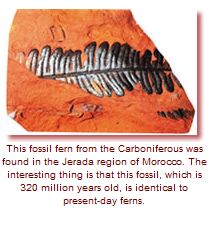When we examine the fossil history and structural features of plants that live on land, another picture emerges which fails to agree with evolutionist predictions. There is no fossil series to confirm even one branch of the "evolutionary tree" of plants that you will see in almost any biological textbook. Most plants possess abundant remains in the fossil record, but none of these fossils is an intermediate form between one species and another. They are all specially and originally created as completely distinct species, and there are no evolutionary links between them. As the evolutionary paleontologist E. C. Olson accepted, "Many new groups of plants and animals suddenly appear, apparently without any close ancestors."343
The botanist Chester A. Arnold, who studies fossil plants at the University of Michigan, makes the following comment:
It has long been hoped that extinct plants will ultimately reveal some of the stages through which existing groups have passed during the course of their development, but it must be freely admitted that this aspiration has been fulfilled to a very slight extent, even though paleobotanical research has been in progress for more than one hundred years.344
Arnold accepts that paleobotany (the science of plant fossils) has produced no results in support of evolution: "[W]e have not been able to track the phylogenetic history of a single group of modern plants from its beginning to the present."345
The fossil discoveries which most clearly deny the claims of plant evolution are those of flowering plants, or "angiosperms," to give them their scientific name. These plants are divided into 43 separate families, each one of which emerges suddenly, leaving no trace of any primitive "transitional form" behind it in the fossil record. This was realised in the nineteenth century, and for this reason Darwin described the origin of angiosperms as "an abominable mystery." All the research carried out since Darwin's time has simply added to the amount of discomfort this mystery causes. In his book The Paleology of Angiosperm Origins, the evolutionary paleobotanist N. F. Hughes makes this admission:
… With few exceptions of detail, however, the failure to find a satisfactory explanation has persisted, and many botanists have concluded that the problem is not capable of solution, by use of fossil evidence.346
In his book The Evolution of Flowering Plants, Daniel Axelrod says this about the origin of flowering plants,
The ancestral group that gave rise to angiosperms has not yet been identified in the fossil record, and no living angiosperm points to such an ancestral alliance.347
All this leads us to just one conclusion: Like all living things, plants were also created. From the moment they first emerged, all their mechanisms have existed in a finished and complete form. Terms such as 'development over time," "changes dependent on coincidences," and "adaptations which emerged as a result of need," which one finds in the evolutionist literature, have no truth in them at all and are scientifically meaningless.
343 E. C. Olson, The Evolution of Life, The New American Library, New York, 1965, p. 94.
344 Chester A. Arnold, An Introduction to Paleology, McGraw-Hill Publications in the Botanical Sciences, McGraw-Hill Book Company, Inc., New York, 1947, p. 7.
345 Chester A. Arnold, An Introduction to Paleobotany, McGraw-Hill Publications in the Botanical Sciences, McGraw-Hill Book Company, Inc., New York, 1947, p. 334.
346 N. F. Hughes, Paleology of Angiosperm Origins: Problems of Mesozoic Seed-Plant Evolution, Cambridge University Press, Cambridge, 1976, pp. 1-2.
347 Daniel Axelrod, The Evolution of Flowering Plants in The Evolution Life, 1959, pp. 264-274.)
344 Chester A. Arnold, An Introduction to Paleology, McGraw-Hill Publications in the Botanical Sciences, McGraw-Hill Book Company, Inc., New York, 1947, p. 7.
345 Chester A. Arnold, An Introduction to Paleobotany, McGraw-Hill Publications in the Botanical Sciences, McGraw-Hill Book Company, Inc., New York, 1947, p. 334.
346 N. F. Hughes, Paleology of Angiosperm Origins: Problems of Mesozoic Seed-Plant Evolution, Cambridge University Press, Cambridge, 1976, pp. 1-2.
347 Daniel Axelrod, The Evolution of Flowering Plants in The Evolution Life, 1959, pp. 264-274.)


No comments:
Post a Comment